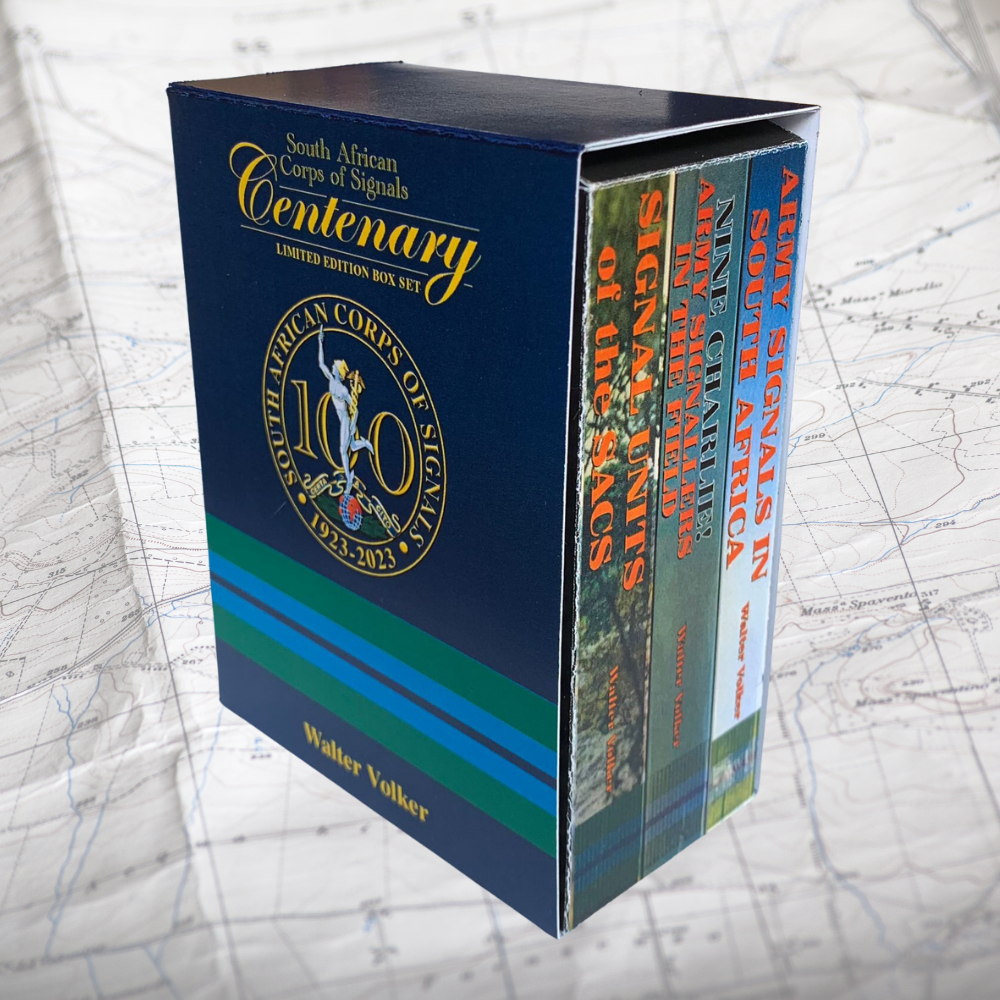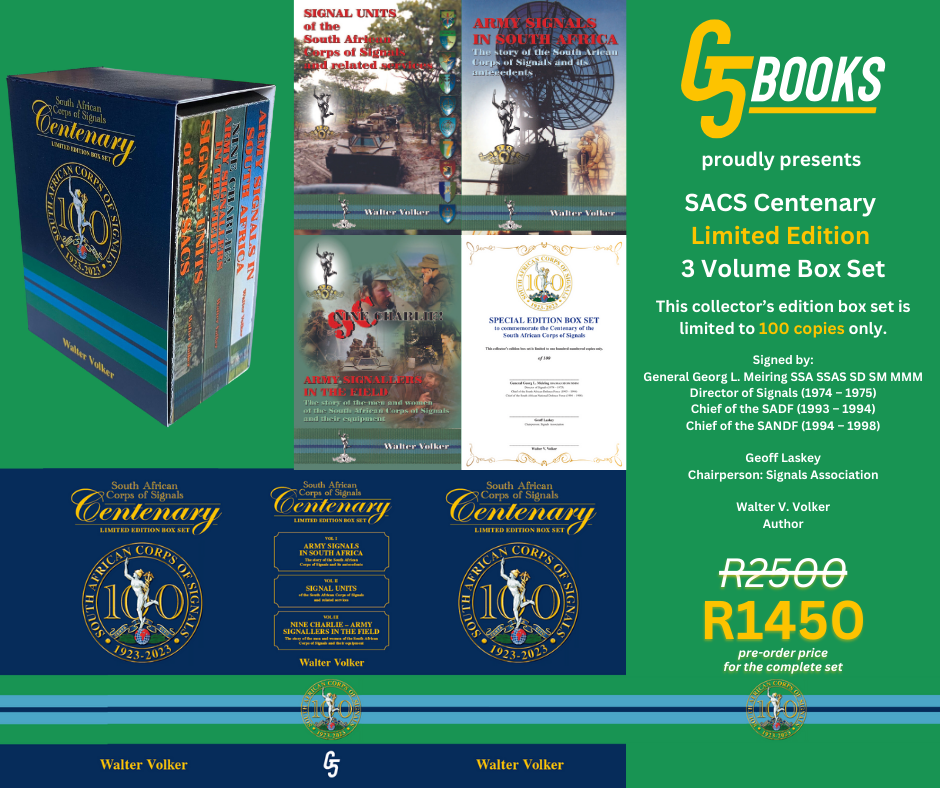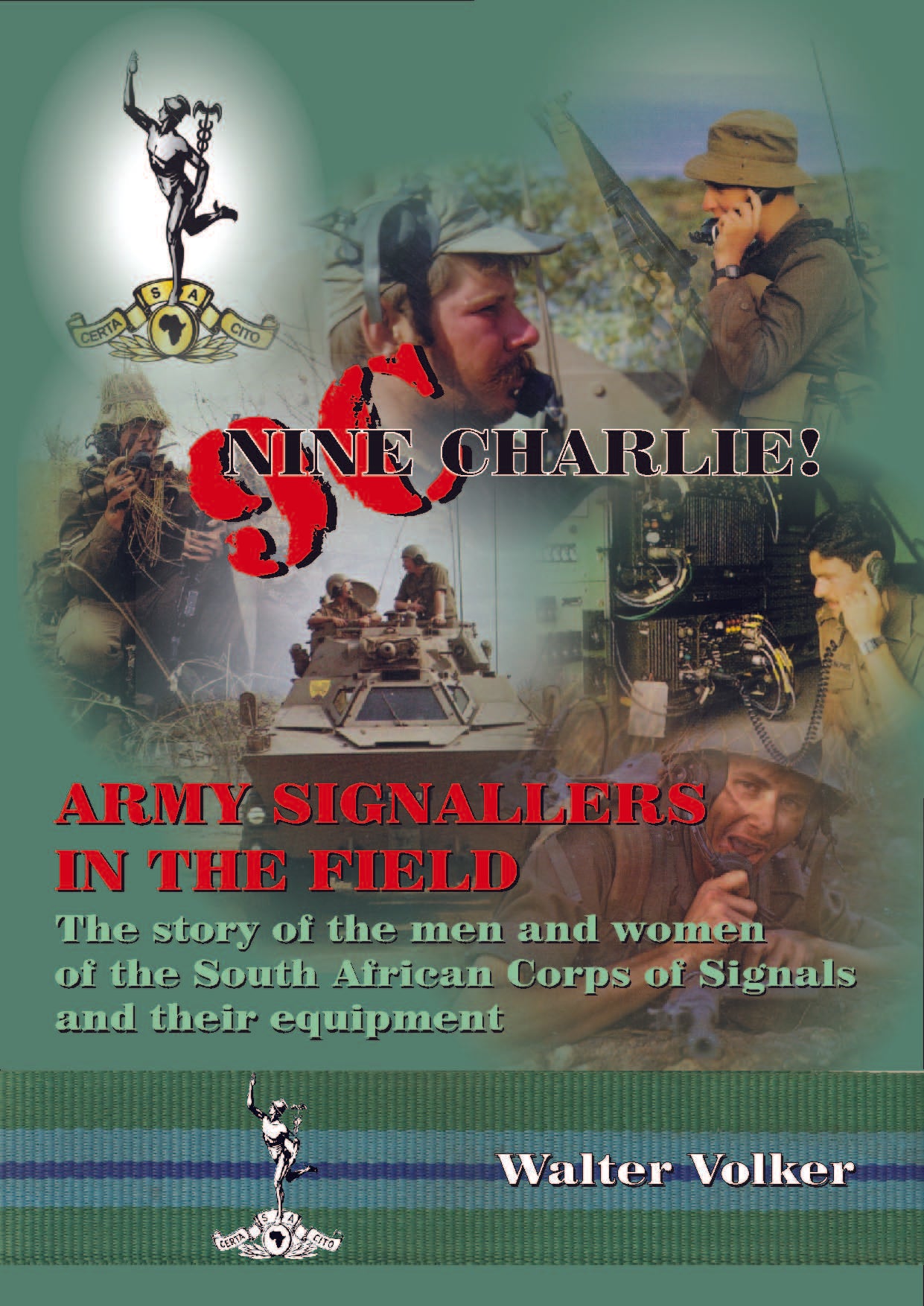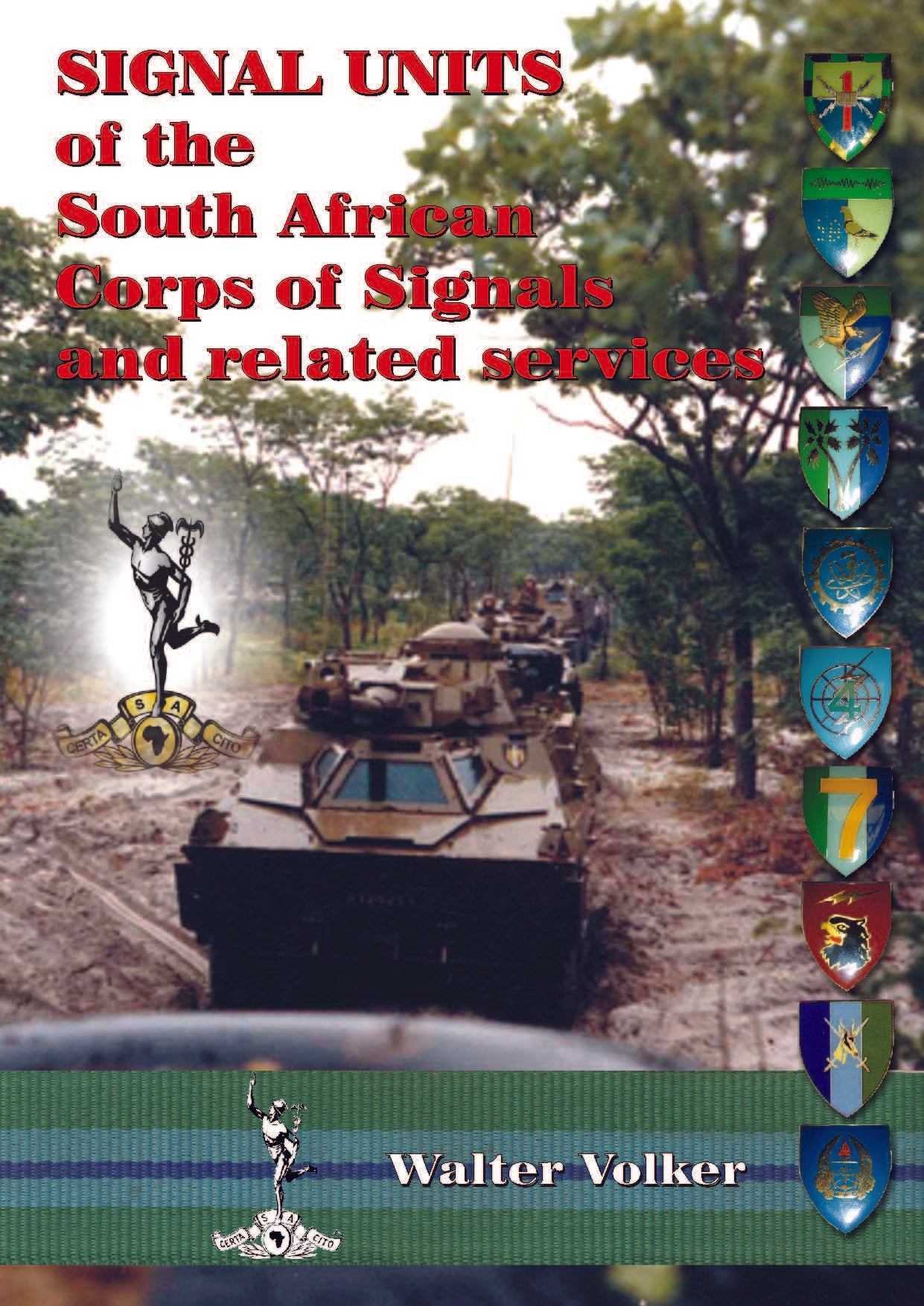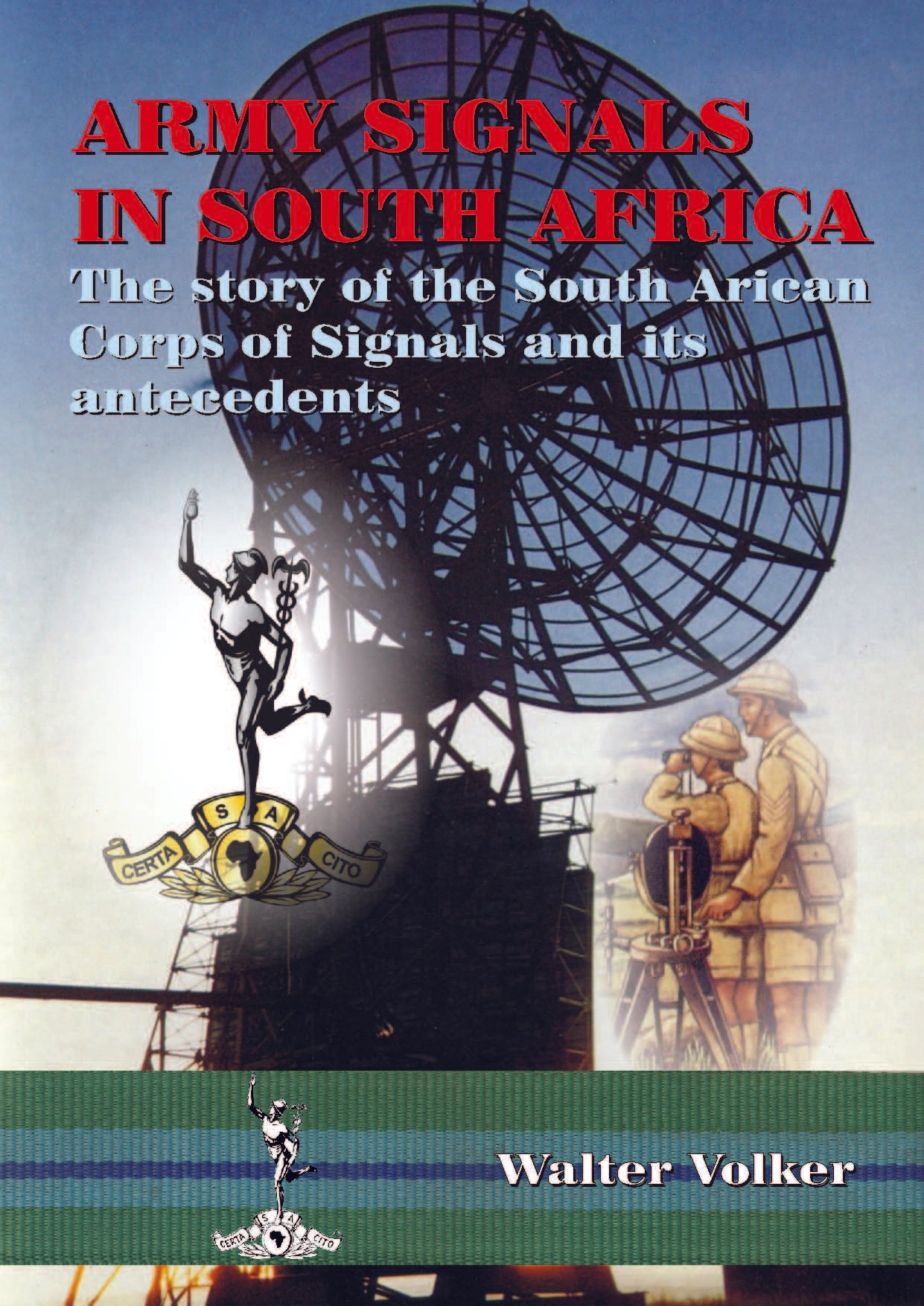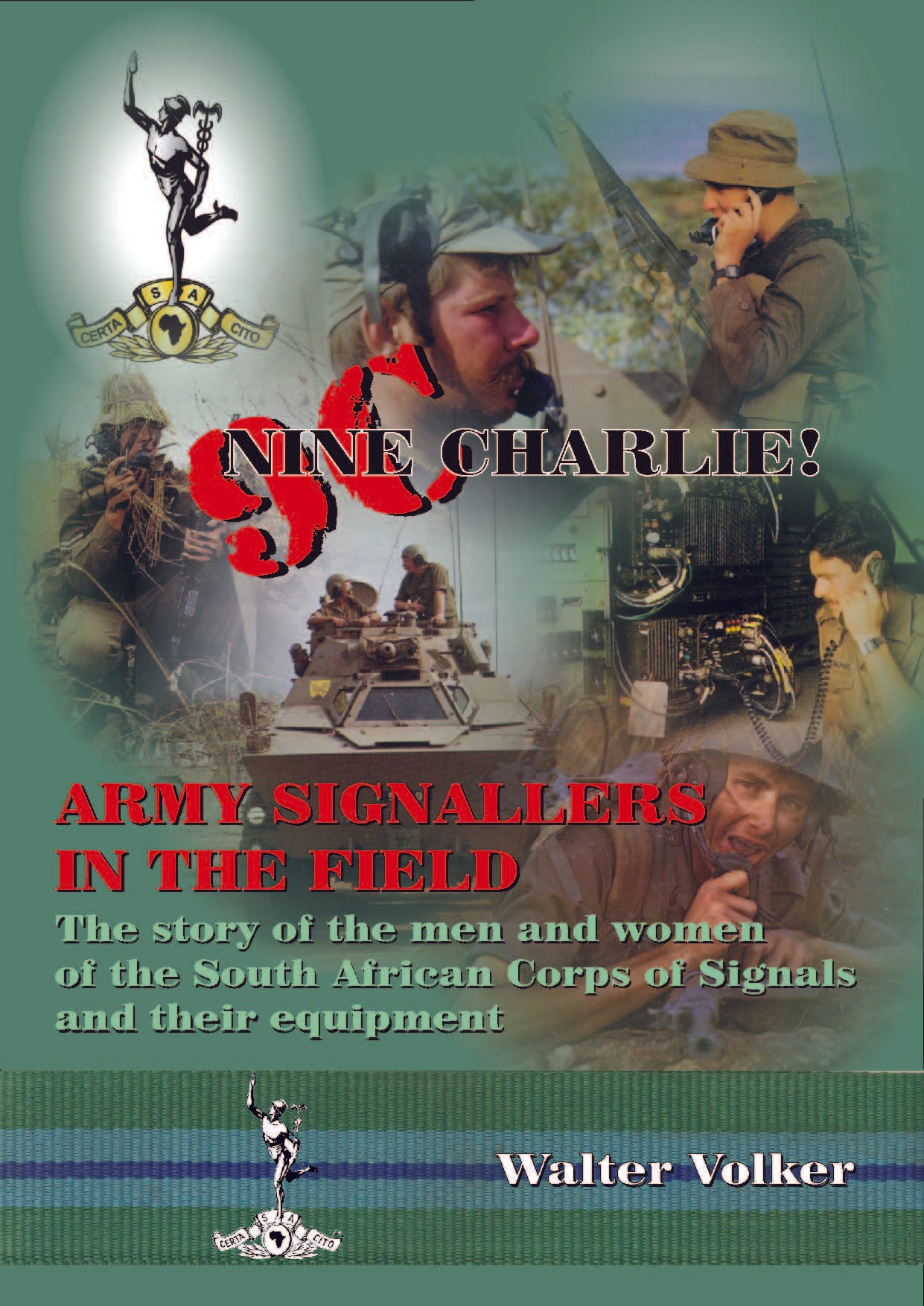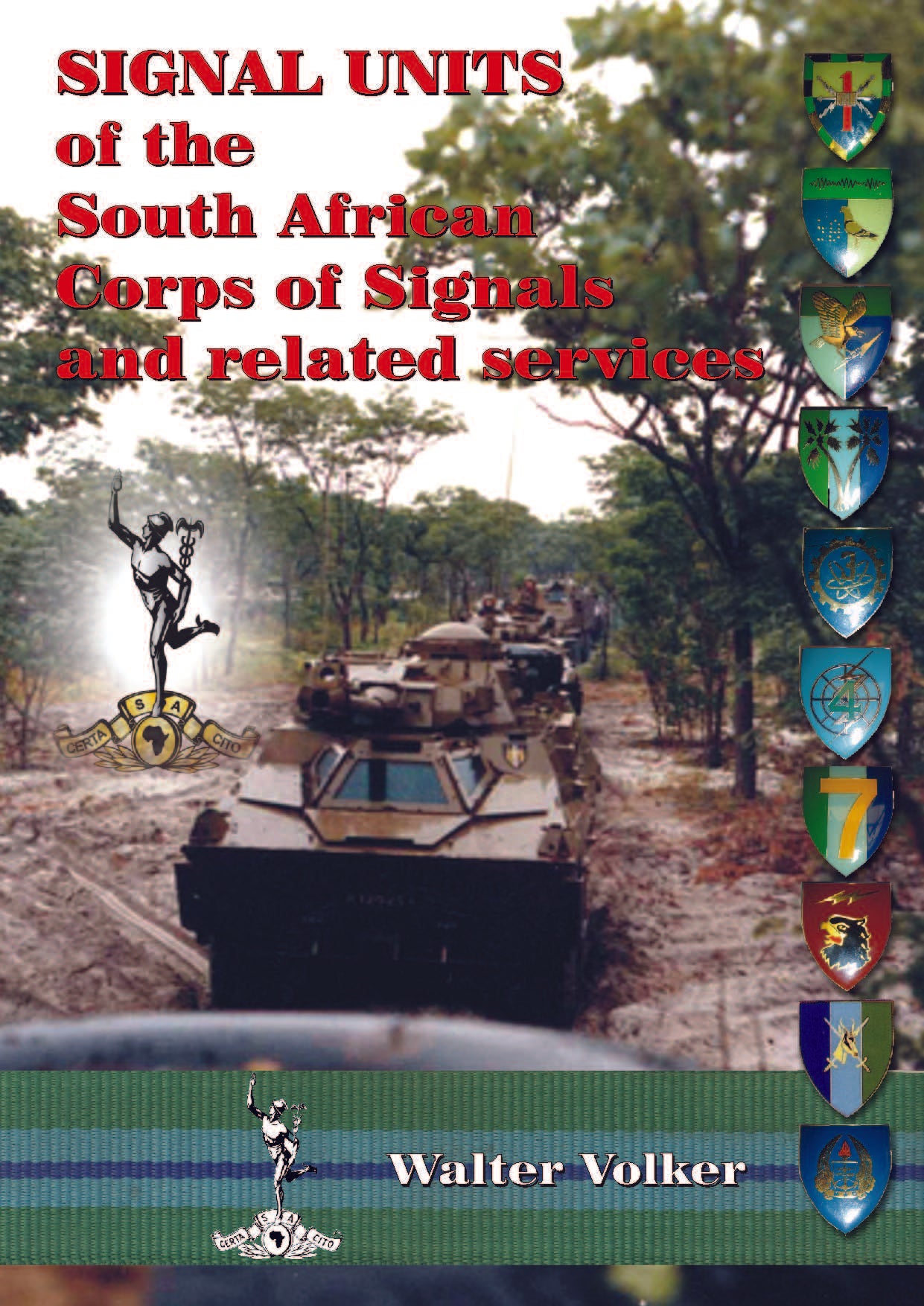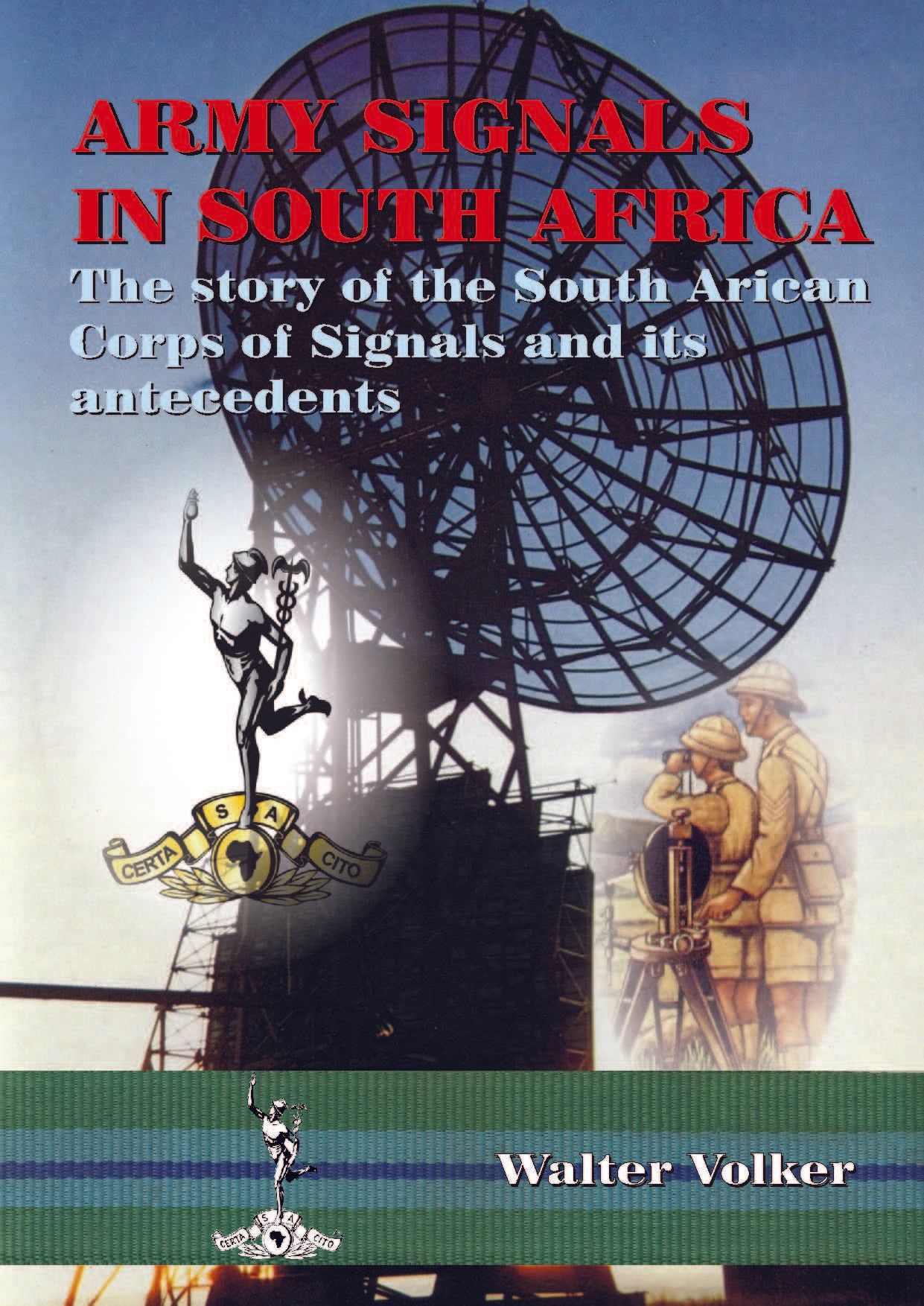G5 Books
SACS Centenary Limited Edition 3 Volume Box Set
SACS Centenary Limited Edition 3 Volume Box Set
Kon nie bakkie beskikbaarheid laai nie
G5 Books proudly presents
SACS Centenary Limited Edition 3 Volume Box Set
This collector’s edition box set is limited to 100 copies only.
Signed by:
General Georg L. Meiring SSA SSAS SD SM MMM
Director of Signals (1974 – 1975)
Chief of the SADF (1993 – 1994)
Chief of the SANDF (1994 – 1998)
Geoff Laskey
Chairperson: Signals Association
Walter V. Volker
Author
. The respective titles are as follows:
• ARMY SIGNALS IN SOUTH AFRICA. The Story of the South African Corps of Signals and its antecedents’
• ‘SIGNAL UNITS OF THE SOUTH AFRICA CORPS OF SIGNALS AND RELATED SIGNAL SERVICES’
• ‘9C – Nine Charlie! ARMY SIGNALLERS IN THE FIELD. The Story of the Men and Women of the South African Corps of Signals, and their Equipment’
The format is A4 in size, with a softcover, and with numbers of pages ranging from 650 to 850 pages in length. Each volume contains many pages of photos, including about fifty pages of colour photos.
Some comments from General Georg Meiring, the last Chief of the SADF and first Chief of the SANDF
This book, which I might add is an enormous task, is packed with achievements... The SACS needs this treatise on its history, the olds and bolds of the corps need the flash-back into "nice old times", the military students past present and future would find it beneficial to enlarge their knowledge and because of its integral relation to the Army as a whole, it would be a major reference work on the past and present South African Army. As time goes by some things are forgotten or become vague. This work will do much to prevent important facts of our past to slip into the haze of forgetfulness. I would urge everyone, especially the students of military history and members of present day telecommunication services in military organisations all over the world to study this work. It is not just a book of history, but is the story of success in the military world, second to none; how achievement was reached against all odds through dedication loyalty and hard work.
Who should own these books
What makes this collection such a worthwhile addition to the library of any student of military history, is the fact that the signals/communications role is relevant to almost every part of the military machine; as a consequence it provides a good overview of operational aspects as well as behind-the-scenes developments in terms of Electronic Warfare – electronic collection, direction finding, jamming etc. The innovations and inventions that were necessary as a result of South Africa’s isolation during recent decades are also well covered.
Interest in this magnificent collection will come from:
• Past serving members of the SACS over the last few decades (estimated at over 100,000)
• People interested in military communications in general, be their interest in South Africa specifically, or more generally in Commonwealth countries
• Past and present serving members of the UDF/SADF/SANDF who have an interest in the preservation and recognition of achievement in any field of endeavour related to the defence force
• People interested in the South African military history in general, including Boer War, world wars, border war and more recent developments within the SANDF
• Suppliers of equipment and/or services to the SACS and its antecedents in mutual recognition of their respective roles in ensuring success and achievement in both spheres of endeavour
The first book, entitled ‘ARMY SIGNALS IN SOUTH AFRICA. The Story of the South African Corps of Signals and its antecedents’ is impressive work of epic proportions, and together with its two companion volumes, will most probably prove to be the book of reference on army signals in South Africa.
This first volume is a compilation of some previously published material, but consists mainly of new material never before published or accessible to the general public, large parts which have come from verbal recollections, rather than documentation. It is the result of thorough and meticulous research, including over two hundred personal interviews, stretching over a period of many years. Interviewees range from a number of generals to the lowest troop, to ensure a level of authenticity and reality in all aspects of this history. The result of including numerous personal accounts sprinkled throughout the pages of the book is that the history literally comes alive and creates a sense of personal experience and interest, rather than just a record of dry facts. The author/compiler has also gone to pains in ensuring names and places are mentioned wherever possibly, not just dates and events – again this serves to give the account a greater level of human interest.
This work consists of a chronological sweep of the history of land-based signals in South Africa, starting with the role of the British army signallers and those of the independent Boer Republics before and during the Boer War, through the two world wars, then on through its climax in manpower and resources during the Border War (1966 to 1989), the involvement of Military Intelligence in setting up the first Electronic Warfare stations, through to the modern era of incorporation of the liberation forces and independent homelands. The transformation resulting from being a part of the newly post-1994 SANDF is also covered in detail.
The second section is one of the most comprehensive studies of ceremonial matters as far as they relate to the SA Corps of Signals and related signal units – covering badges, flashes, mottoes, songs and traditions.
What makes this a worthwhile addition to the library of any student of military history, is the fact that the signals/communications role is relevant to almost every part of the military machine; as a consequence it provides a good overview of operational aspects as well as behind-the-scenes developments in terms of Electronic Warfare – electronic collection, direction finding, jamming etc. The innovations and inventions that were necessary as a result of South Africa’s isolation during recent decades are also well covered. The book also contains one of the most comprehensive lists of border operations yet published.
TABLE OF CONTENTS
PART I: BACKGROUND AND EARLY HISTORY
1. Early Roots
2. Early British Signals
3. Early Signals in South Africa (1652 – 1880)
PART II: SA Signals during the Anglo-Boer Wars (1880 -1881 and 1899 – 1902)
4. Field Telegraphy in the South African Republic (ZAR)
5. Field Telegraphy in the OFS Republic State Artillery
6. British Signals during the Anglo-Boer War (1899-1902)
PART III: REORGANISATION AND UNIFICATION
7. Post-War Consolidation and Reorganisation
8. The Bhambatha Rebellion
9. Reorganisation and Unification
10. Establishment of the Union Defence Force (UDF) in 1912
PART IV: SA Signals during World War I (1914 – 1918)
11. The Campaign in German South West Africa
12. Confusion in German East Africa
13. The Signals in Europe
PART V: SA Signals between the Wars (1919 – 1939)
14. Motivation for a Signals Corps
15. Procurement of new Technical Equipment
16. A Signals Corps becomes a necessity
17. The Establishment of the South African Corps of Signals (SACS) in 1923
18. Inadequate Equipment
19. Problems with Establishment Tables are Resolved
20. The SACS liaises with the Outside World
21. Signals Equipment and Other Problems
22. The Radio Reserve of the UDF
23. Reorganisation of the UDF and SACS
24. Reorganisation of the SACS and early Training (1937-1940)
PART VI: SA Signals during World War II (1939 – 1945)
25. Signal Units in South Africa during World War II
26. The Development of Radar and the SSS
27. The Signals in East Africa
28. The War in the Desert
29. The Signals in Madagascar
30. 6 South African Armoured Division in Italy
PART VII: THE SACS DURING THE IMMEDIATE POST-WAR PERIOD FROM 1946 TO 1967
31. Demobilisation and Reorganisation (1946 to 1956)
32. Major Political Changes in 1948
33. Draft System introduced in 1953
34. Consolidation 1957 to 1959
35. The end of the Union Defence Force (UDF) (1912 – 1958) and the Establishment of the SA Defence Force (SADF) in 1958
36. Becoming a Republic in 1961
37. Permanent Force Units established in 1962 – 11 Signals Squadron
38. Additional Citizen Force Units established: 1964 to 1967
39. The Republic Celebrates 5 Year Anniversary in 1966 – 11 Signals Squadron contribution
40. The Post of Secretary of Defence abolished in 1967
41. National Service system adopted in 1967
42. Prelude to Insurgency 1957 to 1967 – Radio Freedom
43. The Role of Command Signal Squadrons/ Units
Part VIII: THE SACS IN THE “BORDER WAR” (1966 to 1989) and “STRUGGLE” PERIOD TO 1993
44. The start of the SWA Border War and Insurgency into South Africa
45. Development of an own Strategic and Tactical EW capability initiated in 1968
46. Development of HF and VHF Tactical Radios initiated in 1968
47. Establishment of 1 Signal Regiment in 1969
48. Republic Day 10 Year in 1971 – 1 Signal Regiment contribution
49. Rationalisation of Signal Unit Identification Numbers in 1971
50. Development of Static Command and Control Telecommunications Systems initiated in 1972 – Project Ebbehout
51. Establishment of 2 Signal Regiment, 3 Electronic Workshop and 4 Electronic Workshop in 1972
52. Golden Jubilee and the First and Only Brigade Parade of the SACS in 1973
53. Movement of the School of Signals and 1 Signal Regiment to Heidelberg in 1973
54. Adoption of the Army Gymnasium in 1973
55. The SADF takes over SAP Tasks in 1 Military Area, SWA in 1973
56. Development of a Mobile Command and Control Telecommunications Systems capability initiated in 1974 – Project Netor
57. Establishment of 1 SA Corps (7 Div and 8 Div) and their Signal Units in 1974
58. Establishment of the unconventional forces Commands and their Signal Units in 1974
59. Development of the MARNET System for the Commandos in 1974
60. Establishment of Staff Departments – Personnel, Intelligence and Logistics in 1975
61. National Service extended from 12 to 24 months in 1978
62. State Security Council (SSC) and Chief of Finance established in 1978
63. The Army Battle School established in 1978
64. The SAMS established as the Fourth Defence Force arm in 1979
65. The Laingsburg Flood and 20th Republic Day Celebrations in 1981
66. The Move to the Wonderboom Military Base in 1981
67. Establishment of 5 Signal Regiment in 1981
68. Establishment of the Signal Formation in 1982
69. Reorganisation of the Commands in 1983
70. Reorganisation of the Conventional Forces in 1983
71. Signing of the Nkomati Accord in 1984
72. Regional Conflict: The Contribution of the SACS during Border War Operations from 1966 to 1989
73. Peace Negotiations leading to the Independence for SWA/ Namibia and the end of the Border War 1988 to 1990
74. Other Cross-Border Operations in Neighbouring and Frontline States
75. The Role of the SACS during the height of the Internal “Struggle” and the Township Violence from 1984 to 1993
PART IX: REDEPLOYMENT AND DEMOBILISATION OF THE SACS FROM 1989 TO 1993
76. Op Agree: Withdrawal from SWA/ Namibia
77. Walvis Bay: Telecommunications and EW
78. Redeployment of Project Metal from SWA to the RSA
79. Major Political Changes
80. Reorganisation of Conventional Forces
81. Establishment of the National Peace Keeping Force Signal Unit
PART X: THE SACS DURING THE TRANSFORMATION PERIOD POST-1994
82. Political Transition
83. The end of the SA Defence Force (SADF) (1958 – 1994) and the establishment of the SA National Defence Force (SANDF) in 1994
84. Integration of MK, APLA and TBVC countries’ Military Forces
PART XI: TRANSFORMATION AND RESTRUCTURING: CENTRALISATION AND DECENTRALISATION FROM 1996 TO 2008
85. Transformation and Reorganisation of the SANDF (1996 – 1999)
86. Migration of the SA Corps of Signals and the Signals Formation to the new CMI Division in 1999
87. Downgrading the CMI Division to the CMI Formation in 2000
88. The Establishment of the CMIS Division in 2003
89. Peacekeeping Signals
90. Phasing out of the Commando System from 2003
91. Establishment of the role of the Government Information Technology Officer (GITO) in 2005
92. Decentralisation and Migration of SA Corps of Signals and the Signals Formation back to the SA Army in 2008
93. Conclusion and Post Mortem
PART XII: CEREMONIAL and HERALDIC
94. Background
95. Uniforms and Dress
96. Corps and Unit Insignia, Badges and Emblems
97. Corps Colours
98. Unit and National Colours
99. Corps and Unit Mottoes
100. Corps and Unit Songs
101. First Day Covers
102. Mascots
103. Customs, Distinctions and Traditions
The second volume, entitled ‘SIGNAL UNITS OF THE SOUTH AFRICA CORPS OF SIGNALS AND RELATED SIGNAL SERVICES’ represents one of the most comprehensive collection of regimental and unit histories ever published in one volume in South Africa. It is also the first time that the histories of many of the signal regiments and other units will be published and available to the general public, and will most probably – together with its two companion volumes - prove to be the book of reference on army signals in South Africa.
This work consists mainly of new material never before published or accessible to the general public, large parts which have come from verbal recollections, rather than documentation. It is the result of thorough and meticulous research, including over two hundred personal interviews, stretching over a period of many years. Interviewees range from generals to the lowest signalman, to ensure a level of authenticity and reality in all aspects of this history. The result of including numerous personal accounts sprinkled throughout the pages of the book is that the history literally comes alive and creates a sense of personal experience and interest, rather than just a record of dry facts. The author/compiler has also gone to pains in ensuring names and places are mentioned wherever possibly, not just dates and events – again this serves to give the account a greater level of human interest.
This volume includes a history of each of the major signal units of the SA Corps of Signals, but expands this to include the role of signals elements in special units such as 32 Battalion, the SA Special Forces (the ‘Recces’), Military Intelligence, etc. It also reviews the joint signals coordination function of the Directorate Telecommunications and EW, as well as the communications functions in other arms of the SADF such as the SA Air Force and Navy. Signals services in the Portuguese, Rhodesian and SWA Territory Forces are then examined. This is followed by the role of related organizations such as Armscor, the CSIR, the Radio “hams” and others. For the first time, the signals elements in the liberation movements (the ANC/MK and PAC/APLA) is examined next, and finally the development into the new Command and Management Information systems Division of the post-1994 SANDF.
What makes this a worthwhile addition to the library of any student of military history, is the fact that the signals/communications role is relevant to almost every part of the military machine; as a consequence it provides a good overview of operational aspects as well as behind-the-scenes developments in terms of Electronic Warfare – electronic collection, direction finding, jamming etc. The innovations and inventions that were necessary as a result of South Africa’s isolation during recent decades are also well covered.
ISBN:
TABLE OF CONTENTS
PART I: UNITS OF THE SACS
1. Corps Directorate and the SA Army Signal Formation
2. The School of Signals
3. 1 Signal Regiment
4. The Army Gymnasium
5. 2 Signal Regiment
6. 3 Electronic Workshop
7. 4 Electronic Workshop to 4 Signal Regiment
8. 5 Signal Regiment
9. 6 Signal Regiment
10. 11 Field Postal Unit
11. 7 Signal Group
12. 71 Signal Unit
13. 72 Signal Unit
14. 73 Signal Unit
15. 8 Signal Group
16. 81 Signal Unit
17. 82 Signal Unit
18. 84 Signal Unit
19. 44 Parachute Brigade Signal Unit
20. SA Army Battle School Signal Unit
21. Western Province Command Signal Unit
22. Eastern Province Command Signal Unit
23. Natal Command Signal Unit
24. Orange Free State Command Signal Unit
25. North West Command Signal Unit
26. Northern Transvaal Command Signal Unit
27. Far North Command Signal Unit
28. Eastern Transvaal Command Signal Unit
29. Witwatersrand Command Signal Unit
30. Gauteng Command Signal Unit
31. South Cape Command Signal Unit
32. Northern Cape Command Signal Unit
33. Walvis Bay Military Area Signal Unit
34. Sector 10 Signal Unit
35. Sector 20 Signal Unit
36. Sector 70 Signal Unit
37. 61 Mechanised Battalion Group Signal Troop
38. 32 Battalion Signal Troop
PART II: RELATED SIGNALS SERVICES
39. The Directorate Telecommunications and Electronic Warfare (D Tels and EW)
40. The Chief of Army Staff Logistics and its Directorates
41. Signals Services in the SA Special Forces
42. Signals Services in the South African Air Force (SAAF)
43. Signals Services in the South African Navy (SAN)
44. Signals Services in the South African Medical Services (SAMS)
45. Signals Services in Military Intelligence Division (MID)
46. Signals Services in the South African Police (SAP)
47. Signals Services in the Independent Homelands
48. Links with the SWA / Namibian Corps of Signals
49. Links with the Portuguese Colonial Signals
50. Links with the Rhodesian Corps of Signals
PART III: SPECIAL ROLES AND CONTRIBUTIONS
51. The role of SATEPSA
52. ARMSCOR’s Contribution
53. The Role of the CSIR
54. The Role of Radio Amateurs
55. The SACS Contribution to the Development of the Military Electronics Industry in South Africa
PART IV: SIGNALS SERVICES IN THE LIBERATION MOVEMENTS UP TO 1994
56. SWAPO/ PLAN and its Allies
57. ANC and MK
58. PAC and APLA
PART V: NEW COMMAND STRUCTURES FROM 1999
59. The CMI and CMIS Division
60. The Government IT Officer (GITO)
The third of the trilogy is ‘9C – Nine Charlie! ARMY SIGNALLERS IN THE FIELD. The Story of the Men and Women of the South African Corps of Signals, and their Equipment’, and as its title suggests is focused on the contribution of the people who dedicated their efforts, careers, and even sometimes lives, to ensuring one of the most effective army signals organisations on the globe.
It is estimated that over the decades of its existence over 100 000 signallers were part of the South African Corps of Signals, while many more were affected directly or indirectly by its activities. “9C” refers to the standard call-sign of the Signals Officer – who would play a key role during operations, but also in times of peace. This work also focuses on the equipment that was used by the signallers – the vehicles, the radios, the systems and networks. The equipment vendors that played such a crucial role in the success of this organisation, as well as made a contribution to the flourishing of the electronics industry in South Africa, despite comprehensive sanctions and trade embargoes, are also reviewed. Some of the major projects that the SA Corps of Signals was involved in, and which became part of the common language in the army – Ebbehout, Netor, Bowie, Marnet – are also covered in detail. This book also contains a section of the role of signals in the Southern Oceans and Antarctica.
As is the case with the preceding two volumes, this is also impressive work of epic proportions, and will most probably prove to be the book of reference on army signals in South Africa. This volume is a also primarily a compilation mainly of new material never before published or accessible to the general public, large parts which have come from verbal recollections, rather than documentation. It is the result of thorough and meticulous research, including over two hundred personal interviews, stretching over a period of many years. Interviewees range from a number of generals to the lowest troop, to ensure a level of authenticity and reality in all aspects of this history. The result of including numerous personal accounts sprinkled throughout the pages of the book is that the history literally comes alive and creates a sense of personal experience and interest, rather than just a record of dry facts. The author/compiler has also gone to pains in ensuring names and places are mentioned wherever possibly, not just dates and events – again this serves to give the account a greater level of human interest.
What makes this a worthwhile addition to the library of any student of military history, is the fact that the signals/communications role is relevant to almost every part of the military machine; as a consequence it provides a good overview of operational aspects as well as behind-the-scenes developments in terms of Electronic Warfare. The innovations and inventions that were necessary as a result of South Africa’s isolation during recent decades are also well covered.
ISBN:
TABLE OF CONTENTS
PART I: DRAMATIS PERSONAE
1. Who’s Who of over Six Hundred well known Signallers
PART II: SIGNALLERS DURING WORLD WAR I
2. Signals Officer in German SWA and German East Africa – Maj F.E. Jackson
PART III: SIGNALLERS DURING WORLD WAR II
3. From SSB volunteer to Signals Officer - Col “Kakie” de Klerk
4. From Radio Ham to Director Signals - Col Bert Howes
5. Earning the Military Medal in Italy – Smn Boatwright and Mawdley
PART IV: SIGNALLERS DURING THE BORDER WAR
6. The Father of Electronic Warfare - Maj Gen Gerrit Murphy
7. Photo Essay of some Early Border War Operations - Col Bobby Keller
8. Signals Officer during Operation Modular – Lt Col Marius Venter
9. Experiences of a Senior Signals NCO - WO1 Deon van Zyl
10. Experiences of a National Serviceman in Electronic Warfare - Stuart Robertson
11. Experiences of a Citizen Force Signals Officer - Capt Walter Volker
PART V: MILITARY BASES
12. Over Thirty Military Bases associated with the SACS
PART VI: MAJOR PROJECTS OF THE SACS
13. Summary of Projects
14. Project EBBEHOUT
15. Project NETOR
16. Project MARNET
17. Project BOWIE
PART VII: SIGNALS AND RELATED EQUIPMENT
18. Visual Signals Equipment
19. HF and VHF Radio and General Communications Equipment
20. Multiplex Equipment
21. Teleprinters and Data Entry Terminals
22. Crypto Equipment
23. Radar Equipment
24. Electronic Warfare Equipment
25. Night Vision Equipment
26. Other Signals-Related Equipment
PART VIII: SYSTEMS AND EQUIPMENT VENDORS
27. SMD/ Racal/ Grinel / Grinaker Electronics / SAAB Grintek
28. Grintek Ewation (GEW)
29. United Electronics (UEC)
30. Barlows Communications (Barcom Electronics)
31. Reunert Limited and its Antecedents
32. Siemens Telecommunications
33. Altech
34. C. Plath Gmbh, Hamburg
35. SA Electro-Medical / Rhoode & Schwarz
36. Global Communications
37. Nanoteq
38. Jasco Electronics
39. WEB Systems
40. The SABC and SA Post Office
PART IX: ENVIRONMENTAL MATTERS
41. Nature Conservation in the SACS
42. Signal Support for Weather Stations in the Southern Atlantic Ocean
About the author
Walter Victor Volker was born in the south-eastern Transvaal (now Mpumalanga) town of Piet Retief in 1958. On completion of his matric in 1976, he attended the University of Pretoria, where he obtained a B.Sc. degree with majors in physics, mathematics and philosophy. This was followed by a short stint as a teacher at a mission school in Swaziland, after which he spent most of 1980 with a Christian community based in Washington DC.
He then started his national service in January 1981, with basic training at 3 SA Infantry Battalion in Potchefstroom, after which he was transferred to the Army Gymnasium in Heidelberg, completing an advanced course in army signals and then the Candidate Officers’ course. In November of that year he was transferred to 2 Signal Regiment at Wonderboom, where he participated in a number of Division and Brigade exercises at the Army Battle School as the Mobile Command and Control Communications officer. He continued being involved with 2 Signal Regiment during his Citizen Force years, with the last major operation being two months border duty in mid-1988 during Operation Prone, based at Ondangwa.
In 1983 Walter joined NCR Corporation, which was to prove the start of a seven year career in computer marketing and sales from the Pretoria office. In 1990 he joined Allied bank in Johannesburg, responsible for network strategy planning. Following the Absa merger in early 1991, he worked for Absa for the next 17 years. During 1996 Walter and his wife were seconded to work with MasterCard in New York, USA. On completion of this assignment he returned to establish and head up a new division – Group Payment Systems – as General Manager responsible for all the payment systems of the Absa Group.
In March 2008 Walter was appointed Chief Executive Officer of the Payments Association of South Africa (PASA), which is responsible for the management and regulation of the payment systems in South Africa in support of the South African Reserve Bank.
Apart from a number of post-graduate courses completed at various national and international institutions, including IMD in Lausanne, Switzerland, he also holds an MBL from UNISA’s School for Business Leadership. Over the years he has also served on a number of boards and committees such as the MasterCard Global Debit Board, EMVCo Board of Advisors, International Committee of Payment Association Chief Executives (ICPACE), Bankserv board, Allpay board, PASA council, and others.
Walter is married to Trudie (nèe du Toit) since 1984 and they live in Pretoria. His hobbies include genealogical research, military history, art, jogging. He has published a number of books on genealogy, including The Cotton Germans of Natal; this series represents his first published work in the area of military history.
Deel
